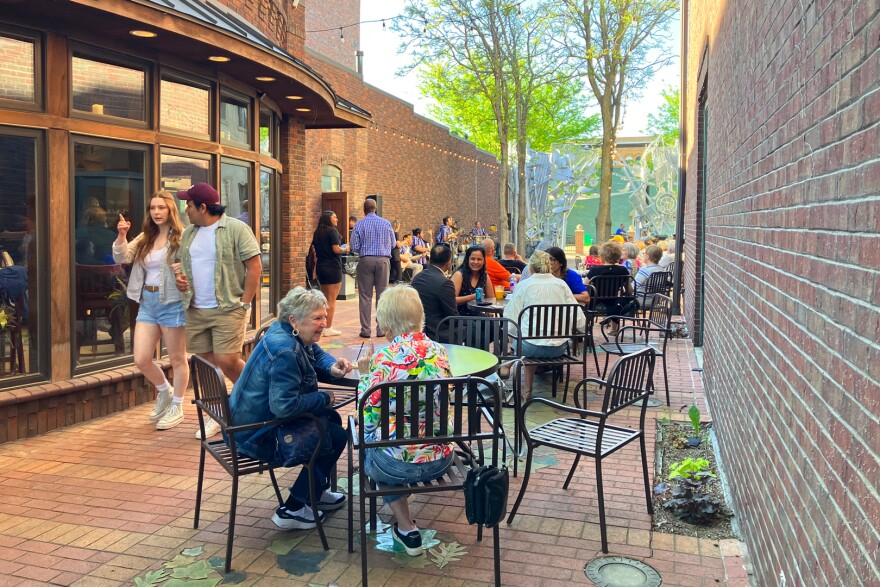Melissa Fabian opened Simply Nourished Market & Mercantile four years ago in Mason City, Iowa. Shoppers can find organic produce and grass-fed lamb from nearby farms and bakeware made across the border in Minnesota at the brick-and-mortar shop.
“We are built upon the backbone of supporting local first,” Fabian said. “So, when you walk into our store, you're really going to see a variety of Iowa and Midwest products.”
But 2025 has been a tough year for Fabian and other small business owners.
“We’ve definitely seen a downturn in customers walking through our door,” Fabian said.
A national survey from nonprofit Main Street America found that 45% of the nearly 1,300 small business owners who responded experienced a drop in net profit this fall.
“In Iowa, just one example, those numbers were more severe,” said Michael Powe, senior director of research at Main Street America. “Fifty-six percent had a net profit decrease.”
Around two-thirds of the survey respondents in Iowa and the U.S. at large were from rural areas, Powe said. Over 60% said they were in the retail and food and beverage sectors.

Many small business owners are also feeling less confident about their business’ success heading into the end of the year. Businesses that employ fewer than three full-time employees reported the second-lowest average confidence rating since the survey began in 2020.
Powe said declining revenue and profit were driving factors. But participants also pointed to economic and social instability, including tariffs, inflation, a government shutdown and shifts in consumer spending.
Along with a decrease in foot traffic this year, Fabian said she’s facing higher transportation and delivery costs for food and kitchenware products made in the region.
“We are paying for the cost of getting the goods to us, and so that has to be reflected in the price of our goods," she said.
Though imports are a smaller slice of her inventory, Fabian said tariffs spiked prices for olive oil, coffee and some of the kitchenware she sells.
She ordered additional inventory before the import taxes went into effect earlier this year. But Fabian said she can’t afford to buy certain products, like the store’s “hottest selling pan,” if they sell out before Christmas.

Woods Prael, owner of Gunzil and Bowser Children's Books in Warrensburg, Missouri, said he’s trying to keep his “head above water” this year.
“Pretty much from February on up to now, consistently, every month, I have been anywhere from 15-22% lower [in sales] than I was the year before,” Prael said.

Prael said his wholesale costs and shipping have increased, and he’s facing higher electricity bills and health insurance. He counts himself lucky that he owns his own building.
“Otherwise, this year would have done me in,” Prael said.
A book fair with a small school district and a birthday party in the store helped his numbers this month, but Prael said a lot hinges on sales in December, typically one of his busiest months.
“I am traditionally an optimist no matter what, but I'm looking at five or six at most [on a scale of 10],” he said. “I'm not real hopeful as to what is to come. I've talked to a lot of the downtown businesses, and they are all in the same exact boat that I am.”
Spending changes
In discussions with customers, Prael said many are hesitant to make purchases because they’re “waiting for the other shoe to drop.” They’re uneasy about their economic futures.
“If you are a consumer worried about what's going to be happening to your food, housing or health care expenses, you might start to cut back on the categories that are less essential or in the categories where you have options,” said Tessa Conroy, associate professor and economic development specialist at the University of Wisconsin-Madison.
That may be fewer trips to a coffee shop or longer periods of time between haircuts, she said. Consumers in rural areas also tend to drive farther for services than their urban counterparts. Paying for gas adds another cost on top of higher prices at restaurants and grocery stores.
But small businesses have also faced increasing competition from Amazon and other e-commerce giants in recent years.
“The ability to order online and the necessity that we recently experienced [with the pandemic] really changed shopping habits, I would say, for many of the small businesses,” said Carrie Poe, a consultant with America’s Small Business Development Center in Lawrence, Kansas.
To adapt to less foot traffic, Poe said some of the businesses in her eight-county area have adjusted their hours. Others are participating in pop-up markets or co-hosting events with businesses or nonprofits to increase visibility.
Expanding their online presence is another way to do this, said Poe. She gave the example of a small clothing shop that streams live events with discounts for customers who tune in.
Researcher Renee Wiatt agreed with Poe, adding that selling products through a subscription-based model – whether it’s for soap or bacon – can also help businesses find new revenue. Wiatt collects data from a 12-state region stretching from Ohio to the Dakotas as part of her role with North Central Regional Center for Rural Development.
“Businesses that have the most success are ones that really fill some kind of niche market, and they get a huge following of local customers who are willing to pour their dollars into that,” Wiatt said.

Impact on local economies
Wiatt said she can understand why the confidence rating in the Main Street America survey is down, given the economic climate and ease of shopping online. Many small business owners also face challenges recruiting and retaining employees and decisions around succession planning.
“The United States is just at a moment where we could have a large-scale transition over the next five to 10 years,” said Conroy, the professor at the University of Wisconsin-Madison. “Many business owners are thinking about retirement and who will take over the business.”
An environment of uncertainty and declining profits for a large number of businesses may make it harder to find a potential buyer, Conroy added. And that could have ripple effects throughout the community.
Locally-owned, independent businesses return more than three times as much money per dollar to their local economy compared to corporate chains, according to the nonprofit American Independent Business Alliance.
And small businesses in rural counties typically account for half of the employment, according to the U.S. Small Business Administration. They’re also more likely to pay for local goods and services. The Main Street America survey found 70% of the small business owners contributed to local causes.
“We rely on local businesses to support Little League and show up at the county fair and be active in the community,” Conroy said. “The downside here is that when we see them struggling, we should also be thinking about how that impacts the community at large.”

Fabian, in northern Iowa, said Small Business Saturday after Thanksgiving is typically the busiest day of the year for Simply Nourished Market & Mercantile. Combined with sales from Black Friday, the two-day stretch is equivalent to the entire month of January.
“Believe me, we appreciate it,” Fabian said. “But we really need the people there to come every week. People can't shop one day a year [at a small business] and be surprised six months later that we're gone.”
Looking ahead to next year, Fabian said she plans to be more cautious about spending and bringing new products into the store.
“I am very optimistic about 2026. That doesn't mean that I'm not going to tighten the bootstraps,” she said.
This story was produced in partnership with Harvest Public Media, a collaboration of public media newsrooms in the Midwest and Great Plains. It reports on food systems, agriculture and rural issues.




